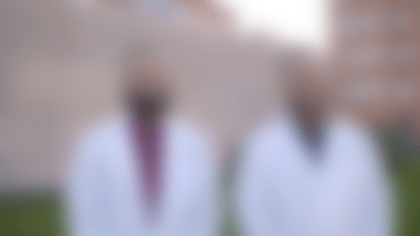The NFL hosted a press conference announcing the NFL Diversity in Sports Medicine Pipeline Initiative on May 24, 2022 from the Spring League Meeting in Atlanta, Georgia.
SPEAKERS:
- Jeff Miller, NFL Executive Vice President overseeing Player Health and Safety
- Dr. Allen Sills, NFL Chief Medical Officer
- Reggie Scott, Acting President, Professional Football Athletic Trainers; Vice President, Sports Medicine and Performance, Los Angeles Rams
- Dr. Timothy McAdams, President, NFL Physicians Society; Head Team Physician, San Francisco 49ers
Jeff Miller: Good morning, everybody. Hope you're all well. Thanks for taking a few minutes.
We're here to talk about an exciting initiative between the League, the Physicians' Society, and the Professional Football Athletic Trainers Society. As you know, a major theme yesterday and today at the League Meeting has been diversity, equity and inclusion. On the medical side and health side, we've spent a fair amount of time thinking and talking about exactly this topic over the last year or so, in ways to broaden diversity among our medical staffs and our medical committees, which we've started to do on the medical committee side now. We've created representation on those committees over the last year or two under Allen's leadership. But among the group here, we've been talking for a while now about the diversity in our sports medical staffs, as well as our athletic training staffs, and have centered on a partnership between the Physicians Society, the Professional Football, Athletic Training Society, and the NFL, to try to increase the pipeline of diverse medical students to participate, eventually, with the league.
We have started an internship program which we're here to announce today, the Sports Medicine Diversity Pipeline Initiative. So, to talk about it, let me introduce the group. You all know Dr. Allen Sills, our Chief Medical Officer. Reggie Scott, who is the head of the Professional Football Athletic Training Society and the Vice President of Sports Medicine at the LA Rams – excuse me, Super Bowl Champion LA Rams – he always corrects me, so I have to say that right. And then Tim McAdams, who is the Head Team Physician with the San Francisco 49ers and the President of the NFL Physician Society. Each of whom is going to make some short remarks and then we're happy to take some questions. So, with that, Allen, maybe we can get into the details of the program.
Dr. Allen Sills: We also want to recognize Dr. John York, who I think all of you know as the owner of the San Francisco 49ers and Chair of the Owners' Health and Safety Advisory Committee, and also really committed to this program. And off the top, let me just echo my thanks for Jeff, to Reggie and Tim for coming here. Both of them, as you heard, are based in California, and I think, you know, their attendance here today shows you how much they are invested in this program and how important they feel it is. So, thanks to both of you for making that time.
You know, as Jeff said, we're committed, the NFL is committed to increasing diversity at all aspects of the league and we've certainly been looking at and talking about this with regard to our medical staffs and all of sports medicine. And today, we want to tell you something that we think is an exciting initiative to help advance that. A partnership, as Jeff said, between the NFL, the NFL Physicians Society and the Professional Football Athletic Trainer Society
You know, there is work to be done here. When we talk about the medical student pipeline, right now, a recent study says Black medical students are only 7.3% of the total medical school population in the U.S., and that has risen less than 1% over the last 40 years. There's really very little progress there. When we look at our own demographics, you know, in the NFL Physicians Society right now, 86% of our membership identifies as white. For the last 40 years, there has really been very little progress there. For the Professional Football Athletic Trainers, it's 65% who identify as white. So, we've got work to do, but we are committed working together to address this lack of diversity. Not just because it's the right thing to do, because we know it makes us better. It actually leads to improved patient outcomes.
So, as you know, we're devoted to the highest quality medical care for our players. We always want that at every aspect of our medical care. And every day, you know, they're more than 30 medical professionals at the club. And so, we begin to look at that and say, "How can we increase the diversity of that group? What can we do?" This initiative is part of a larger effort, as Jeff mentioned. We're starting with a basic program with four medical schools. Those are HBCU medical schools: The Charles R. Drew University School of Medicine and Science, the Howard University College of Medicine, the Morehouse School of Medicine and Meharry Medical College. And we've partnered with those four HBCU medical schools to identify students who are interested in sports medicine, and who will now do clinical rotations with NFL medical staffs in order to expose them to the NFL medicine, if you will.
Eight NFL teams have been chosen to host a total of 16 medical students this year for a one-month clinical rotation. Those rotations will occur in September and October because we want them during our season, so they get to see the full aspect of medical care. Those eight clubs will be: the Atlanta Falcons, the Cincinnati Bengals, the LA chargers, the LA Rams, the New York Giants, the San Francisco 49ers, the Tennessee Titans, and the Washington Commanders. So each of those clubs will host two medical students, one who's interested in primary care sports medicine, and one who's interested in orthopedic surgery. During this rotation, medical students will observe and just really immerse themselves into the NFL clubs sports medicine community. They'll work directly under the supervision of the team athletic trainers and physicians. They will see patients. They will learn and gain knowledge about all aspects of how we do health care in the NFL – from observing athletic training procedures, to observing surgical procedures, to observing examinations and rehab, attending practices and attending games. Really just all the opportunities that we would want to present to expose them to this environment.
And the goal is that by the end of the rotation, the students can understand all the elements that go into the care of the NFL athlete, but as much as anything, I think it's also about mentorship. We really want these students to connect with people who can continue to mentor them, and stay involved with them, and advise them as they enter this pipeline and hopefully choose careers that wind up in sports medicine. So again, this is our first year of doing this. It's our inaugural year, and we hope to expand this program next year to almost all – hopefully all – the NFL teams and will also involve additional medical schools. But in this first year, we wanted to do something of very high-quality and excellence. Of course, in the longer term, we hope to expand this beyond just students who are MD graduates. We certainly want to address the pipeline of people who have interest in athletic training, in strength and conditioning, in sports science, in nutrition, in behavioral health. All these areas, which are an integral part of sports medicine, the NFL today should have diverse groups involved with them and we want to address those pipelines as well.
So, as I said, I'm incredibly excited for this partnership. This is not just a one year, one time program. This is a commitment, an ongoing sustained commitment. And so, what we're talking about today, is one of those first steps but we're very excited about where it will lead us and how it will take us from here. So, with that I'll turn it over to my colleague, Reggie Scott, who is President of the Professional Football Athletic Trainers Society.
Reggie Scott: Thank you, Allen. Thank you, Jeff. And thank you, Tim. I think it's awesome that we're really going to commit to a program like this. I can't thank the NFL enough, and the Physicians Society enough, for allowing us to get this rolling.
When you look at this program, and you think about trying to create diversity in our in our world today, it's all about creating pipelines and awareness. And I think this pipeline is one big step to really ultimately getting better player care, because we know there's better player candidates, a better diverse group of sports medicine physicians, athletic trainers, and so on and so on. So really, really excited about that. From a PFATS perspective, when we look at this program, we were really excited. We've been doing the PFATS ethnic minority scholarship since 1993, and in 2015, we launched the PFATS women's scholarship. We offer a monetary donation to that participant, and they get a three-week or four-week summer internship with various teams in the NFL. And today, we've given out over 1000 of those scholarships, which is awesome. We have seen that pipeline be effective throughout our PFATS profession in terms of really seeing people get exposure and get that time in that environment of the elite athletes.
What's really cool about this is I was a PFATS ethnic minority scholarship winner in 2001. So, this is really full circle for me, to get to sit up here and talk about something like this today that's going to continue that pipeline effect. And just like what Dr. Sills said, I think it's really important for these medical students not only to get the exposure from the orthopedic surgeons and the primary care sports medicine doctors, but also all these subspecialty groups. As you look at the climate, and the change in sports medicine over the last few years, you can really see all the subspecialty groups – with the registered dieticians, sports medicine, obviously strength and conditioning, analytics and performance science, behavioral health. We really want to expose these medical students to all these various subspecialties, just to bring awareness so they know what's going on and understand the different fields that they can get into in the future. And I think we will continue to increase that awareness, and hopefully eventually get to a goal of trying to get more diverse groups in the elite level of sport.
So, super excited to be a representative of the Professional Football Athletic Training Society and couldn't be more excited to be here and be part of this today. And with that, I'll hand it off to Dr. Tim McAdams.
Dr. Tim McAdams: Thank you Reggie. Good morning. As President of the NFL Physicians Society – a group of 180 team physicians who help take care of these players – we're really trying to provide excellence in their surgical and medical care to athletes at all 32 NFL clubs. But we're also working to provide support and some guidance for the Athletic Training Society, and to help them along as well, because they're there day-in and day-out working with the players.
Segueing to, "what's a typical month going to look like for these students when they work with us?" This starts out with the basic core curriculum that's going to be involved with any medical clerkship, basic knowledge of sports medicine, from head to toe, anatomy, physical examination, imaging analysis. But what makes this really exciting, is it's actually a complete total immersion into "what is life like as a team physician." Not only will they spend time in the team physicians' clinics and sometimes in the operating room, but they'll also spend time in the athletic training rooms working with the athletic trainer and a team physician, looking at return-to-play guidelines. They'll go out into the fields of practice, where they'll actually get some exposure into on-field injury management. And, the new sports medicine model now is a diverse group of disciplines. So, they'll spend time with each of those and get exposure. Spend a day with the nutrition group, spend a day with the physical therapy group, spend the day with strength and conditioning, even with performance metrics, and to build relationships with each of these groups will only enhance their experience of what life is going to be like as a team physician – and to get them excited about it.
Mentorship is a critical component of recruiting students into our field and so on behalf of the NFL Physicians Society, we're incredibly excited to be a part of this program and just as excited to see it expand and blossom in years to come. Thank you.
Miller: Great, thanks Tim. I think we'll take a couple questions.
QUESTION: It's one thing to want to bring in more African Americans in the group, but do you have a marketing component for television, so that a person watching who wants to do this will be informed about it, and see the possibilities?
Miller: Good question. Well, first, we're going to start with the medical schools that we referred to, the four medical schools of the HBCUs. And part of that of course, in the pilot program, is going to be word of mouth and hopefully some excitement from the participants who are going to bring the word back from the experiences they had, both with the trainers as well as with the physicians. And with the eight clubs that are participating, and I think some excitement will grow from there. As Allen mentioned, this is going to grow in future years. And I'm hoping – expecting – that we're going to see a fair amount of turnout and excitement among the student population to participate in this. So, as we grow some of the interest and excitement towards sports medicine to diversify the sports medicine profession, and we identify the different avenues that you can pursue to become a sports medicine expert (whether it ends up being at the NFL or college level or other places), I think we're going to see that grow more organically. And that's what we look forward to.
Sills: Yeah, I would just add one thing here – that we've also started having conversations with additional HBCU universities that don't have medical schools, about how we can connect with undergraduate students there who are thinking about these careers because you know, obviously when someone's in medical school, they've kind of committed to that degree path. We want to go even more upstream, if you will, to talk to students about this diversity of careers that Reggie and Tim spoke about. So again, what we're talking about with the pipeline here is one component of the strategy. But we do want to do just what you said, which is to make people realize sports medicine is much more than just orthopedic surgery or primary care in today's world. There are so many avenues, and we want students to catch that excitement early on and to realize that that's a dream that they can pursue. That it's not a narrow door anymore. And that we want to open those doors much wider.
QUESTION: How were the 8 teams selected? Did they volunteer, is it a rotation? I'm particularly interested in the two LA teams, and why they're participating?
Sills: Yeah, first of all, as I said, we wanted to start a little bit smaller, because we want to do something that's of high-quality. And also, when you talk about doing a medical school rotation, there are certain accreditation things and certain curricula that have to be brought up to speed. So, we went out and literally asked for volunteers. And I would think, you know, Tim and Reggie would confirm, we were overwhelmed with volunteers. I mean, everyone wanted to jump in and do this. So, we tried to look at some geographic diversity also, that would be closer to the schools and maybe a little bit easier for students in terms of travel logistics. But the interest was I thought really overwhelming.
Scott: Yeah, and I was going to say about the same, that as soon as we pushed it out to all the PFATS members, in terms of when to get involved – overwhelming. A lot of people wanted to be involved in it, which is awesome. And so, once we got to that, we had kind of had to select, but I think it is important that you know, we have a pilot study. Because I think one of the critical things, let's make sure this is a good experience. Let's make sure it is the right experience and we get what we need to do. And so, I think having a smaller group starting this year, to make sure it's a good program for them, that we advanced this, that the goal can be met for what we're trying to do for these medical students.
QUESTION: For Dr. Sills or Dr. McAdams – Morehouse and the Falcons, can you discuss their parts in the program and is that a natural match to send their students, keeping them locally?
Sills: Well, I think it's obviously a natural match, but both groups have been incredibly enthusiastic. You know, obviously with Morehouse, we've had discussions and will continue to do so, and we consider them a very integral part of this program. And the Falcons also were very quick, you know, even independent of Morehouse's involvement, to reach out and just say they wanted to be a part of this. So, as I said, there's this tremendous enthusiasm on both sides. And I think that you're going to see these partnerships continue to evolve. As I mentioned, other teams next year will be involved, and we'll have additional schools. So you'll see, hopefully, relationships continue to form that extend beyond this program. Because, Dr. McAdams mentioned mentorship, you know, and mentorship is something we think is really important and can continue on. So, for those students who are local, I certainly think there'll be a lot of opportunities for them to have ongoing relationships and mentorship.











